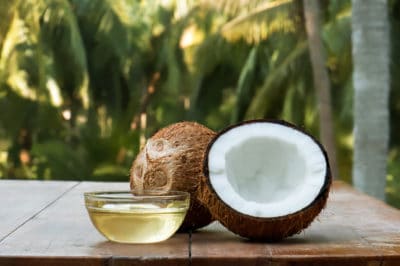Coconut Palm Production Age
The typical coconut palm the average homeowner purchases from their local garden center is generally around two to three years-old. At this age, the palm tree is still small enough to easily handle and plant without assistance. Larger and more mature trees are still available, but you will probably require assistance when it comes to transporting and planting in the landscape.
Coconut palms typically start producing coconuts when they reach six to 10 years-old, with their prime production age at 15 to 20 years-old. The tree continues to produce coconuts for about 80 years. Depending on the tree’s care, climate, and the variety planted, a single palm produces anywhere from 50 to 200 coconuts annually.
It’s All About the Flowers
Once the coconut palm reaches four to six years of age, it starts producing flowers, which eventually develop into the coconuts. Each tree produces both male and female flowers born on 3-foot long, canoe-shaped sheaths, developing among the fronds. There are 10 to 50 branchlets emerging from the sheath holding both types of yellow flowers.
- Male flowers are smaller and located at the ends of the branchlets.
- Female flowers are larger than males and located closer to the base of the branchlets.
Coconut Development
Once the flowers are germinated, small, round, green seeds form from the female flowers and slowly grow larger, eventually developing into full-size coconuts. The entire process from pollination to ready for harvesting, takes approximately one year. However, if you are harvesting the coconuts to drink the milk, it’s best to harvest when the nuts are around seven months old.
Depending on the particular variety, the ripe outer shell of the coconut can be green or yellowish, changing to brown as it ripens. You know the coconut is ready for harvesting if you pick one and shake it, and can hear the fluid inside. You won’t hear the fluid inside if the coconut is harvested too early or is passed its prime.
Ripe Coconut Description
Regardless of the variety of coconut palm grown, all of the ripe fruit have the same characteristics:
- Egg-shaped fruit that is about 15 inches long and 12 inches wide, and composed of a dense, fibrous husk that surrounds the inner nut.
- The 8-inch diameter inner nut is brown, hairy and composed of a hard shell, with three sunken “eyes” at one end.
- Inside the shell is a 1-inch fleshy layer known as the “meat” and the hollow inside contains the coconut milk.
In immature coconuts, the inner flesh is soft and jelly-like and firms up as the coconut matures. As the coconut continues the process of ripening, it gradually absorbs the inner milk.
A Coconut Explosion
With mature, fruit-producing coconut palms producing so many coconuts yearly, you’ll probably end up with more than you’ll know what to do with. Of course, you can always make pina coladas and relax as you revel in your successful harvest.
